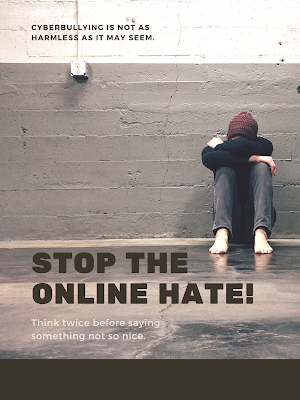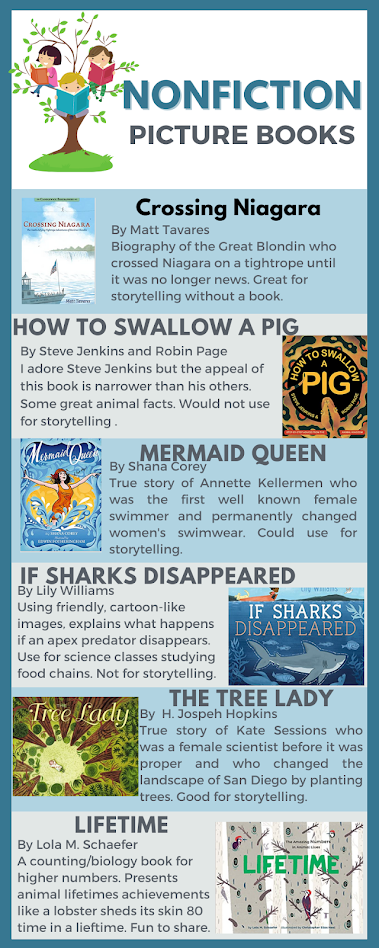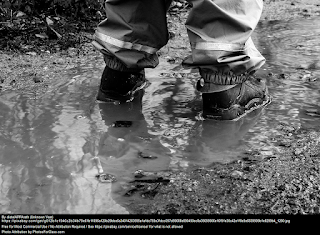Cyberbullying
 |
| A poster on Canva |
Cyberbullying is almost 2 decades old now. There are books and even movies that show the power of a post, a video or a meme. Still, there are few things I learned this week that reminded me of how important this topic is.
Things I learned
In reading the article, "From the Sandbox to the Inbox", I was surprised at the consistency of bullying throughout life from K-12 all the way to the workplace. Also, as a parent and a teacher observing students, I have suspected that cyberbullying was more prominent among females and was an especially big problem among female friend problems. This article confirmed my own observations.
I thought comparing the impact of bullying to burn degrees was super helpful. If I teach older kids, I think this analogy is helpful. Here is how the author described it: "First-degree burns (and low levels of bullying) are common, superficial, quick to heal, but prolonged or repeated exposure can lead to problems. Second-degree burns (and more intensive, frequent, and persistent bullying) are more painful and require more intervention to heal. Third-degree burns (and escalated cases of bullying) can 'result in deep scarring and permanent damage.'"
How To Address Bullying with Students
Currently, I do not have the opportunity to teach students, only check out books ( I can share books on bullying). Several things stood out to me
 |
| A poster from Canva |
1) From the Sandbox to the Inbox indicates that 61% of kids who experience cyberbullying also experience in person bullying in the k-12 setting. What is helpful in this stat, is the possibility that teaching about one type of bullying might also improve the other. It is sobering to consider that by the time they graduate from high school over 25% of our kids will experience some kind of bullying (the percentage varies with the source, but 25% is a conservative median).
2) Schools need to have clear anti-bullying policies in place. They need to be followed. Similarly, schools need a way for students to report bullying that is safe and well known. This one is tougher and will require a building by building solution. At one school where I worked, we had a mailbox for the counselor in the library. Students could fill a slip to report bullying of any kind. It was not anonymous and was not used often. We tried anonymous but found kids would report things to get others in trouble without an actual incident. One time, there was group of fifth grade girls who were squabbling with each other. They kept coming in to fill out a form about the other half of the group. The counsellor really had to have a pulse on what was happening and who was actually being bullied. It was exhausting for her since stories never matched up. I do think the library is a good place for reporting bullying. It is sort of a neutral place, not belonging to any one class and not a place you go when someone is in trouble. I think a librarian could serve on a committee that makes the anti-bullying rules or investigates them. They do serve a good understanding of the pulse of the school. And they hear things.
 |
| Defining true friendship can be part of anti-bullying education |
3) In "How It's Done: Incorporating Digital Citizenship into Your Every Day Curriculum," Orech writes, "As in many states, students in Illinois are required to receive a certain number of hours of instruction each year dedicated to Internet Safety. While the idea is noble, the parameters are sketchy. Some schools have an “Internet Safety Day” or some such “special occasion” but too often these “occasions” serve no purpose other than compliance with the requirement and very little learning occurs." Digital Citizenship and anti-cyberbullying lessons are not a one and done deal. A speaker, a video, a one time lesson will not teach our kids the principles we want them to learn. I love the high schoolers mentoring middle schoolers model of this article. It would require effort to train and monitor the high schoolers, but I can imagine the middle schoolers would learn more. And the high schoolers might become convinced of the need for online kindness. A win-win.
I don't know how I will address cyberbullying with students when I have opportunity to teach again. It will depend on their age and the time we have. I am convinced that digital citizenship, digital footprints, and cyberbullying are part of ongoing lessons that cannot be done once and forgotten.
Resources:
Orech, J. (2012). How it's done: Incorporating digital citizenship into your everyday curriculum. Tech & Learning, 33(1), 16-18.
Faucher, C., Cassidy, W., & Jackson, M. (2015). From the sandbox to the inbox: Comparing the acts, impacts, and solutions of bullying in k-12, higher education, and the workplace. Journal Of Education And Training Studies, 3(6), 111-125.



Hello! This is a difficult topic to teach in that it is so pervasive. Bullying/Cyberbullying really is everywhere and it is so easy to miss certain aspects of it because it can become normal seeming. Little behaviors, when put together, can form a much bigger and scarier picture. I appreciate the fact that you're not certain how you are going to handle it-that means you are thinking and considering. That's all we can do until we are in the mix of it. Thank you!
ReplyDelete